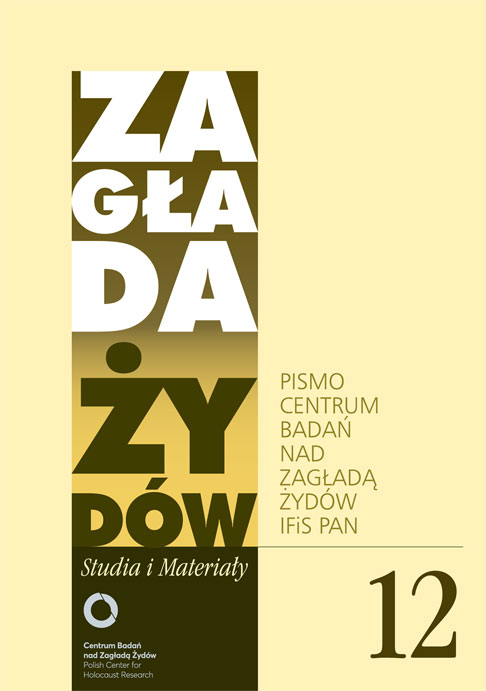Frankenstein w warszawskim getcie. Historia i legenda
Zagłada Żydów. Studia i Materiały, Nr 12 (2016), Strony: 187-208
Data zgłoszenia: 2020-10-19Data publikacji: 2016-11-30
 https://doi.org/10.32927/ZZSiM.414
https://doi.org/10.32927/ZZSiM.414
Abstrakt
The article deals with one exceptionally violent German perpetrator who was part of the occupation force in Warsaw during the Second World War. Inside the Ghetto he maltreated and killed a large number of women, children and men for his own personal pleasure. He did this to such an extensive degree that the population perceived him as monstrous being that was given the nickname „Frankenstein”. The article is mainly based on statements in juridical investigations, from the victim as well as from the perpetrator perspective, supplemented with some selected additional sources. Firstly the source corpus will be evaluated, to work out how these historical sources can be used to shed light on „Frankenstein”. This will be followed by an analysis of the actual identity of this perpetrator. It will be shown that he was, contrary to common belief, not necessarily the SS-Rottenführer Josef Blösche but more likely a member of the German Police Battalion 61. In the end the question will be also raised of how it was possible – despite all rules and regulations – that ghetto guards like him behaved like a marauding soldiery.
Słowa kluczowe
getto warszawskie , Zagłada , policja umundurowana , zbrodnie okupacyjne , warty w getcie , batalion policyjny , sprawca , przemoc , strach , terror , życie w getcie
Licencja
Prawa autorskie (c) 2016 Autor&"Zagłada Żydów. Studia i Materiały"

Utwór dostępny jest na licencji Creative Commons Uznanie autorstwa 4.0 Międzynarodowe.
https://creativecommons.org/licenses/by/4.0
Czasopismo publikowane jest w standardzie Diamond Open Access na licencji CC-BY-4.0 Deed - Uznanie autorstwa 4.0 Międzynarodowa - Creative Commons
Podobne artykuły
- Mikołaj Grynberg, Samuel Willenberg in memoriam , Zagłada Żydów. Studia i Materiały: Nr 12 (2016)
- Israel Gutman, Listy Emanuela Ringelbluma w opracowaniu Israela Gutmana , Zagłada Żydów. Studia i Materiały: Nr 1 (2005)
- Anna Wylegała, Niezauważony potencjał? Historia mówiona w polskich badaniach nad Zagładą , Zagłada Żydów. Studia i Materiały: Nr 20 (2024)
- Krzysztof Rybak, Zagłada (nie) dla dzieci. Nadużycia w polskiej literaturze dziecięcej XXI wieku , Zagłada Żydów. Studia i Materiały: Nr 17 (2021)
- Maria Ferenc, „Zrozumiałe, że zostajemy na miejscu”. Działacze chalucowi wobec perspektywy ucieczki z okupowanej Polski , Zagłada Żydów. Studia i Materiały: Nr 19 (2023)
- Karolina Panz, Sieci przetrwania – przemytnicy z Podhala i Spisza w czasie Zagłady , Zagłada Żydów. Studia i Materiały: Nr 18 (2022)
- Karolina Panz, tłumaczenie dzienika B. Kalba z jidysz Monika Polit, tłumaczenie dziennika B. Kalba z jidysz - Ewa Kuma-Zielińska, „Na pamiątkę dla Pańskich synów i przyszłych pokoleń, by oddać cześć Pańskim czynom” – materiały do historii przemytnika Benziona Kalba , Zagłada Żydów. Studia i Materiały: Nr 18 (2022)
- Katarzyna Person, Gabriel N. Finder, Alexander V. Prusin, Justice behind the Iron Curtain: Nazis on Trial in Communist Poland; Andrew Kornbluth, The August Trials: The Holocaust and Postwar Justice in Poland [Katarzyna Person] , Zagłada Żydów. Studia i Materiały: Nr 17 (2021)
- Dariusz Libionka, Uwagi o ratowaniu Żydów w „okolicach Treblinki” [recenzja: Edward Kopówka, ks. Paweł Rytel-Andrianik, Dam im imię na wieki. Polacy z okolic Treblinki ratujący Żydów] , Zagłada Żydów. Studia i Materiały: Nr 9 (2013)
- Karolina Panz, Agnieszka Wierzcholska, Wspomnienia i kamienie. Życie i śmierć polsko-żydowskiego miasta Tarnów 1918–1956 , Zagłada Żydów. Studia i Materiały: Nr 20 (2024)
<< < 4 5 6 7 8 9 10 11 12 13 14 15 16 17 18 19 20 21 22 23 24 25 26 27 28 29 30 31 32 33 34 35 36 37 38 39 40 41 42 43 44 45 46 47 48 49 50 51 52 53 > >>
Możesz również Rozpocznij zaawansowane wyszukiwanie podobieństw dla tego artykułu.
 English
English
 Język Polski
Język Polski




